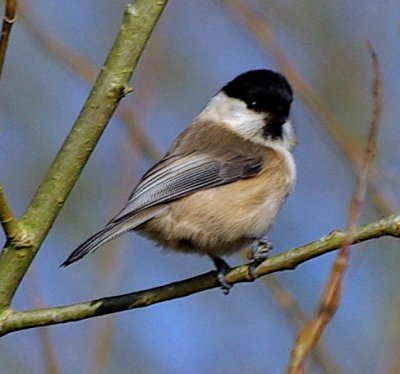Willow Tit Poecile montanus kleinschmidti
A resident fairly widespread in England and Wales, closely resembling the Marsh Tit {Parus palustris}. In fact in Britain it resembles the Marsh Tit so much that it was not discovered as a separate species until 1897 by Pastor Kleinschmidt and Dr. Hartert who were looking at skins in the British Museum. The Willow Tit was already known as a species in Europe separate from the Marsh Tit, but the British form of the Willow Tit was much darker than the continental form so it was misidentified as Marsh Tit.
Willow Tits have undergone severe declines and contractions in their ranges since the 1970s, 85% between 1970 and 2003 {Ibis, Volume 149; 2007} and around 80% between 1980 and 2005 {BTO/JNCC Breeding birds in the wider countryside }. Interestingly from the Common Birds Census (CBC) the population reached a peak in the early 1970s after recovering from a previous dip in population. Possible reasons are the increasing Great spotted Woodpecker population; competition with other tit species and Nuthatches, for nest sites and foraging for food and thirdly; habitat changes. Grey Squirrels and Jays may also affect the population.
The past status of Willow Tits in Nottinghamshire is uncertain, because of the confusion in identifying it in the past. In a review of the status of Willow and Marsh Tits in Britain, the December 1937 edition of British Birds just gives two records of Willow Tit in Nottinghamshire!! Austin Dobbs in The Birds of Nottinghamshire(1975) says that it was "uncommon/fairly common resident, but rather local".
Great spotted Woodpeckers can predate Willow Tit young by excavating the nest hole {Nottinghamshire Birdwatchers annual report 2007}, but according to a statistical analysis by Garvin M. Siriwardena {Bird Study 51(2004)} the abundance of Great spotted Woodpeckers does not relate to the decline of the Willow Tit, so presumably this is a hazard that has dogged Willow Tits for eons.
Alex Lewis {Nottinghamshire Birdwatchers annual report 2007} found that of a survey of 65 woods in North Nottinghamshire in 2006, 29 were occupied by Willow Tits. An analysis of the habitat of the woods found that Willow Tits were much more likely to be found in the younger, damper ones with few conifers present.

Difficult to separate from the Marsh Tit. Visible clues are the larger "bull neck" of the Willow Tit compared with the Marsh Tit. The cheeks of the Willow Tit are whiter, the white also curves up to the nape exaggerating the "bull neck". The Willow Tit also has a panel on the wing secondaries, which is also a good fieldmark. Although I have seen Willow Tits with a pale panel on one wing and no panel on the other. I have also seen a Marsh Tit with a single white feather in one wing giving the impression of a panel at first glance.
Also as noted above habitat can be a good indicator of the species, with Willow Tit preferring damp woodland such as Alder Carr, whilst the Marsh Tit prefers mature deciduous woodland with a good understory.
Any criticisms, corrections or comments to the author Derek Huskisson

This work is licensed under a Creative Commons Attribution-Noncommercial-Share Alike 2.0 UK: England & Wales License.
